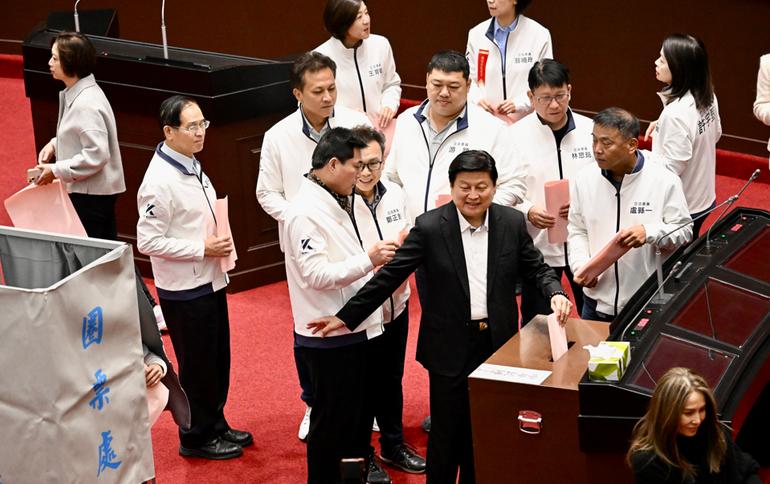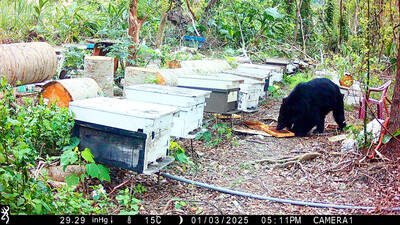The Legislative Yuan today voted to approve the 14th president and vice president of the Examination Yuan and six new commissioners, ending a months-long stalemate after the previous members’ terms ended in August.
The results were released at midday, with only Ker Li-ling (柯麗鈴), president of the Academy for the Judiciary and a prosecutor at the Supreme Prosecutors’ Office, failing to gain legislators' support.
Examination Yuan Vice President Chou Hung-hsien (周弘憲) has been approved to head the nation’s highest examination body next term, having received 59 votes in favor and 53 against, Legislative Speaker Han Kuo-yu (韓國瑜) said.

Photo: Lo Pei-de, Taipei Times
Former minister of examination Hsu Shu-hsiang (許舒翔) is to take over Chou’s position as Examination Yuan vice president after receiving 112 affirmative votes.
The terms for the previous Examination Yuan officials expired on Aug. 31. President William Lai (賴清德) nominated the new members in May.
According to The Law Governing the Legislative Yuan’s Exercise of Power (立法院職權行使法), nominees must win more than half of the legislators’ support, or 57 votes, to be approved.
As Ker received only 51 votes, with 57 negative votes and four legislators abstaining, she would not serve as a commissioner this term, Han said.
Chinese Nationalist Party (KMT) Legislator Chen Yu-jen (陳玉珍) said that party members maintained an open approach to considering the nominations, with no agenda to reject certain nominees.
After a lively debate this morning, the caucus decided to vote against Chou and Ker, she said.
Taiwan People's Party (TPP) legislators decided to vote against commissioner nominees Ker and Iwan Nawi, TPP caucus whip Huang Kuo-chang (黃國昌) said before the vote.
However, TPP Legislator Vivian Huang (黃珊珊) said she voted incorrectly, accidentally marking both options on her ballot.
The TPP decided to vote against Ker due to her lack of understanding and familiarity with the Examination Yuan and its functions in prior questioning, and against Iwan Nawi, as the party believes she did not fulfill her responsibilities as commissioner in the previous term, Huang said.
Additional reporting by CNA

SHIPS, TRAINS AND AUTOMOBILES: The ministry has announced changes to varied transportation industries taking effect soon, with a number of effects for passengers Beginning next month, the post office is canceling signature upon delivery and written inquiry services for international registered small packets in accordance with the new policy of the Universal Postal Union, the Ministry of Transportation and Communications said yesterday. The new policy does not apply to packets that are to be delivered to China, the ministry said. Senders of international registered small packets would receive a NT$10 rebate on postage if the packets are sent from Jan. 1 to March 31, it added. The ministry said that three other policies are also scheduled to take effect next month. International cruise ship operators

NUMBERS IMBALANCE: More than 4 million Taiwanese have visited China this year, while only about half a million Chinese have visited here Beijing has yet to respond to Taiwan’s requests for negotiation over matters related to the recovery of cross-strait tourism, the Tourism Administration said yesterday. Taiwan’s tourism authority issued the statement after Chinese-language daily the China Times reported yesterday that the government’s policy of banning group tours to China does not stop Taiwanese from visiting the country. As of October, more than 4.2 million had traveled to China this year, exceeding last year. Beijing estimated the number of Taiwanese tourists in China could reach 4.5 million this year. By contrast, only 500,000 Chinese tourists are expected in Taiwan, the report said. The report

The Forestry and Nature Conservation Agency yesterday launched a gift box to market honey “certified by a Formosan black bear” in appreciation of a beekeeper’s amicable interaction with a honey-thieving bear. Beekeeper Chih Ming-chen (池明鎮) in January inspected his bee farm in Hualien County’s Jhuosi Township (卓溪) and found that more than 20 beehives had been destroyed and many hives were eaten, with bear droppings and paw prints near the destroyed hives, the agency said. Chih returned to the farm to move the remaining beehives away that evening when he encountered a Formosan black bear only 20m away, the agency said. The bear

Chinese embassy staffers attempted to interrupt an award ceremony of an international tea competition in France when the organizer introduced Taiwan and displayed the Republic of China flag, a Taiwanese tea farmer said in an interview published today. Hsieh Chung-lin (謝忠霖), chief executive of Juxin Tea Factory from Taichung's Lishan (梨山) area, on Dec. 2 attended the Teas of the World International Contest held at the Peruvian embassy in Paris. Hsieh was awarded a special prize for his Huagang Snow Source Tea by the nonprofit Agency for the Valorization of Agricultural Products (AVPA). During the ceremony, two Chinese embassy staffers in attendance